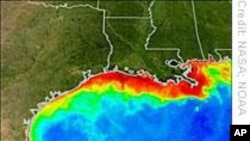U.S. scientists say an area of oxygen-depleted water in the Gulf of Mexico, known as the “dead zone,” will reach a near-record size this season.
Scientists from the National Oceanic and Atmospheric Administration (NOAA) predicted Monday the annual dead zone this summer will cover more than 20,000 square kilometers, roughly the size of Slovenia.
They say that size, if borne out, would be the second-largest dead zone on record, just smaller than in 2017, when the dead zone reached 22,700 square kilometers, close to the size of Turkey.
A separate forecast Monday from scientists at Louisiana State University also predicted an unusually large dead zone.
The Gulf of Mexico dead zone -- one of the largest dead zones in the world -- is at the bottom of the body of water. A dead zone occurs when there is not enough oxygen to support marine life. It threatens all aquatic life in the water, and can deplete the numbers of fish, shrimp and crabs caught in the Gulf.
NOAA said in its news release Monday that the prediction for a large dead zone is because of an “abnormally high amount of spring rainfall in many parts of the Mississippi River watershed,” which led to high amounts of fertilizer downriver.
The fertilizers feed algae, which then die on the sea floor and use up oxygen as they decompose.
The size of the average Gulf dead zone is about 15,000 square kilometers. U.S. federal and state officials have previously pledged to reduce its size to less than 5,000 square kilometers.
NOAA said its forecast assumes typical coastal weather conditions, but said the actual size of the dead zone could be affected by major wind events, including hurricanes and tropical storms, which bring more ocean waters into the Gulf. Official numbers on the size of the dead zone will be measured later in the summer.
Annual measurements of the dead zone began in 1985. There is another annual dead zone in the mid-Atlantic’s Chesapeake Bay.
